Workplace Sustainability Policy Report for Strong Australia
VerifiedAdded on 2020/12/10
|15
|4790
|365
Report
AI Summary
This report, prepared for a Diploma of Business, analyzes the development and implementation of a workplace sustainability policy for Strong Australia, a consumer electronics manufacturer. The report is divided into two parts. Part A focuses on planning, including information gathering from industry guidelines, best practices, relevant personnel, and legislative requirements. It details methods for writing the policy document, including structure, writing style, and stakeholder consultation. Part B outlines the policy itself, defining its scope, developing the policy, outlining relevant systems and procedures, and addressing organizational commitment and policy implementation. The report emphasizes the importance of stakeholder engagement, including customers, employees, investors, the community, technical specialists, and suppliers, and strategies to minimize resource use, reduce toxic materials, and promote life cycle management. The assignment provides a detailed examination of sustainability policy creation and practical application within a business context, available on Desklib.
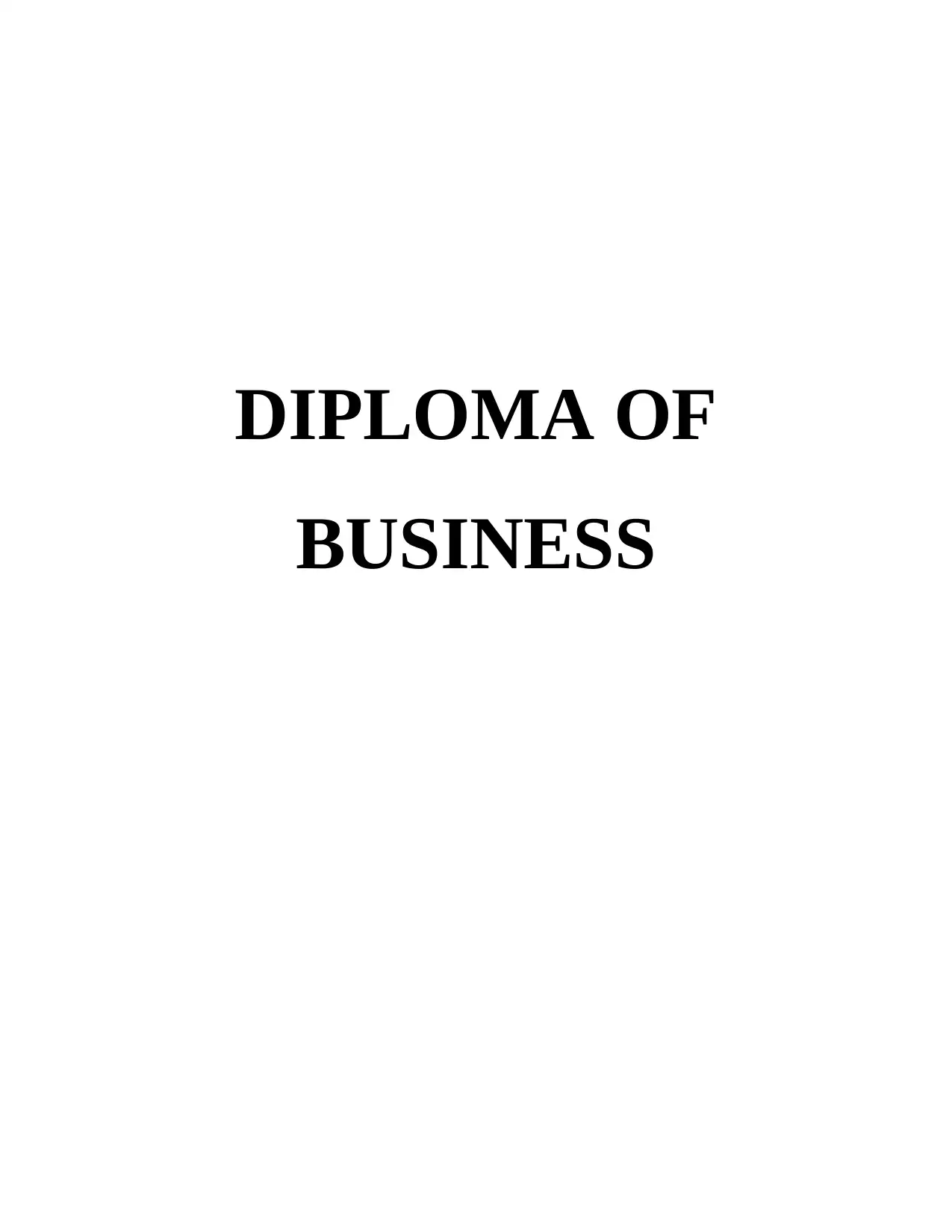
DIPLOMA OF
BUSINESS
BUSINESS
Paraphrase This Document
Need a fresh take? Get an instant paraphrase of this document with our AI Paraphraser
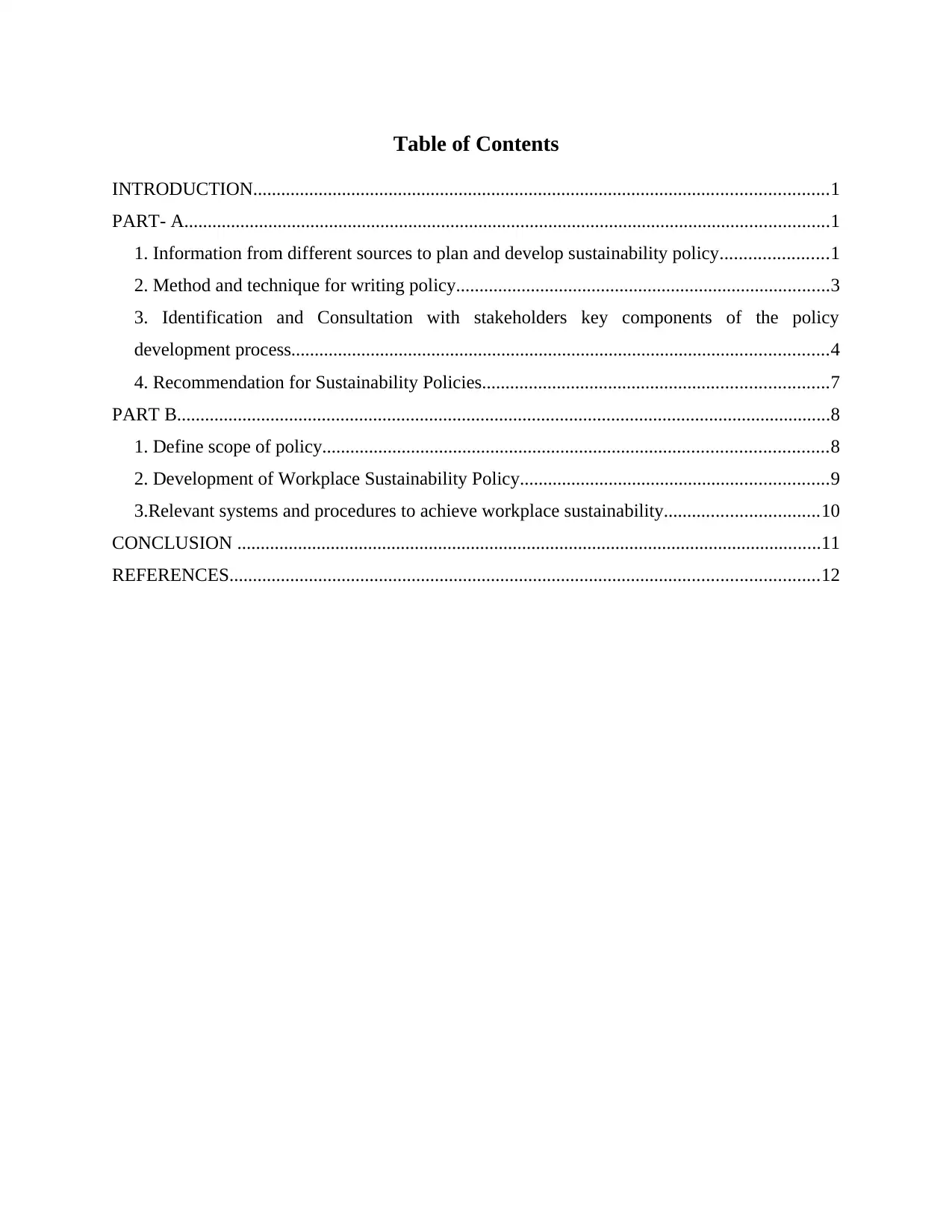
Table of Contents
INTRODUCTION...........................................................................................................................1
PART- A..........................................................................................................................................1
1. Information from different sources to plan and develop sustainability policy.......................1
2. Method and technique for writing policy................................................................................3
3. Identification and Consultation with stakeholders key components of the policy
development process...................................................................................................................4
4. Recommendation for Sustainability Policies..........................................................................7
PART B............................................................................................................................................8
1. Define scope of policy............................................................................................................8
2. Development of Workplace Sustainability Policy..................................................................9
3.Relevant systems and procedures to achieve workplace sustainability.................................10
CONCLUSION .............................................................................................................................11
REFERENCES..............................................................................................................................12
INTRODUCTION...........................................................................................................................1
PART- A..........................................................................................................................................1
1. Information from different sources to plan and develop sustainability policy.......................1
2. Method and technique for writing policy................................................................................3
3. Identification and Consultation with stakeholders key components of the policy
development process...................................................................................................................4
4. Recommendation for Sustainability Policies..........................................................................7
PART B............................................................................................................................................8
1. Define scope of policy............................................................................................................8
2. Development of Workplace Sustainability Policy..................................................................9
3.Relevant systems and procedures to achieve workplace sustainability.................................10
CONCLUSION .............................................................................................................................11
REFERENCES..............................................................................................................................12
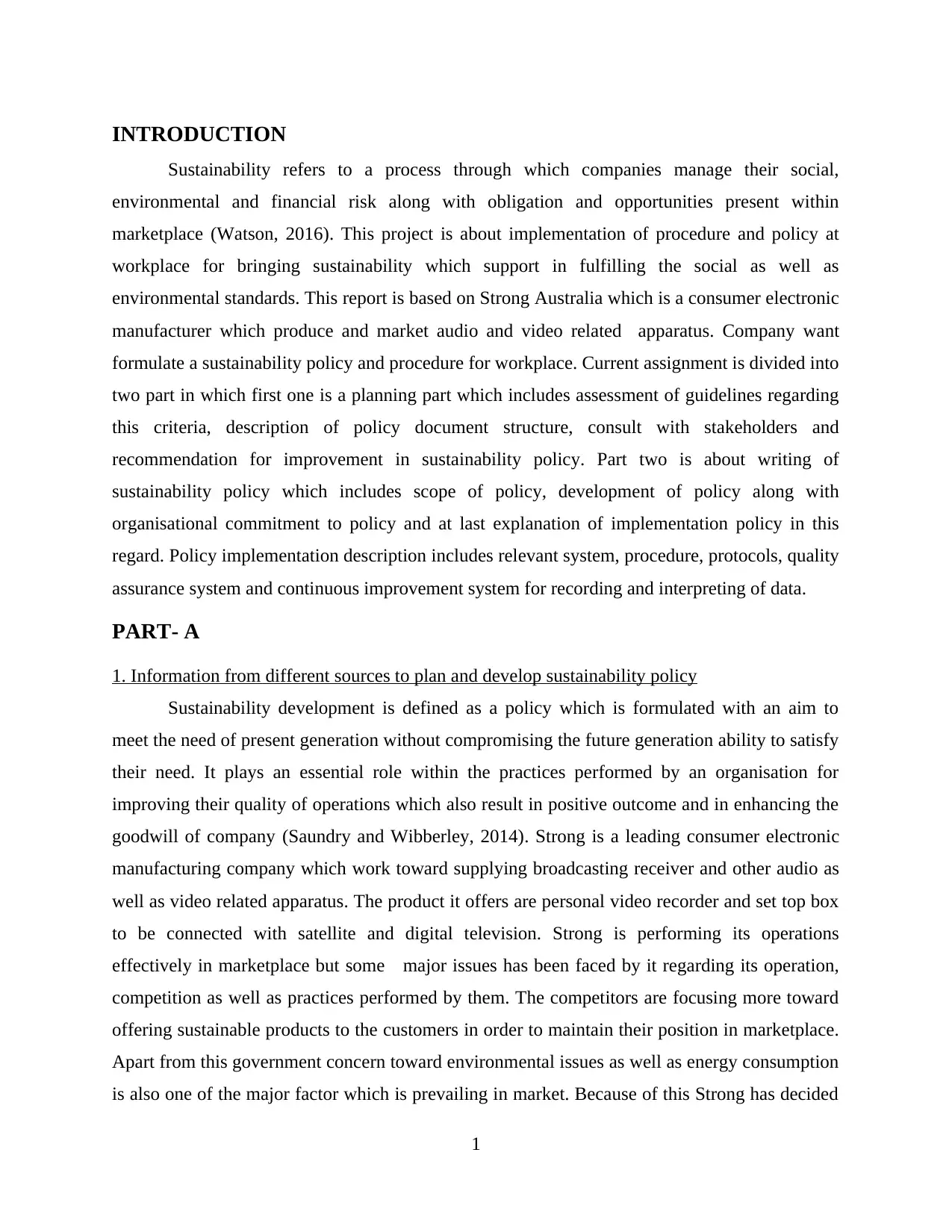
INTRODUCTION
Sustainability refers to a process through which companies manage their social,
environmental and financial risk along with obligation and opportunities present within
marketplace (Watson, 2016). This project is about implementation of procedure and policy at
workplace for bringing sustainability which support in fulfilling the social as well as
environmental standards. This report is based on Strong Australia which is a consumer electronic
manufacturer which produce and market audio and video related apparatus. Company want
formulate a sustainability policy and procedure for workplace. Current assignment is divided into
two part in which first one is a planning part which includes assessment of guidelines regarding
this criteria, description of policy document structure, consult with stakeholders and
recommendation for improvement in sustainability policy. Part two is about writing of
sustainability policy which includes scope of policy, development of policy along with
organisational commitment to policy and at last explanation of implementation policy in this
regard. Policy implementation description includes relevant system, procedure, protocols, quality
assurance system and continuous improvement system for recording and interpreting of data.
PART- A
1. Information from different sources to plan and develop sustainability policy
Sustainability development is defined as a policy which is formulated with an aim to
meet the need of present generation without compromising the future generation ability to satisfy
their need. It plays an essential role within the practices performed by an organisation for
improving their quality of operations which also result in positive outcome and in enhancing the
goodwill of company (Saundry and Wibberley, 2014). Strong is a leading consumer electronic
manufacturing company which work toward supplying broadcasting receiver and other audio as
well as video related apparatus. The product it offers are personal video recorder and set top box
to be connected with satellite and digital television. Strong is performing its operations
effectively in marketplace but some major issues has been faced by it regarding its operation,
competition as well as practices performed by them. The competitors are focusing more toward
offering sustainable products to the customers in order to maintain their position in marketplace.
Apart from this government concern toward environmental issues as well as energy consumption
is also one of the major factor which is prevailing in market. Because of this Strong has decided
1
Sustainability refers to a process through which companies manage their social,
environmental and financial risk along with obligation and opportunities present within
marketplace (Watson, 2016). This project is about implementation of procedure and policy at
workplace for bringing sustainability which support in fulfilling the social as well as
environmental standards. This report is based on Strong Australia which is a consumer electronic
manufacturer which produce and market audio and video related apparatus. Company want
formulate a sustainability policy and procedure for workplace. Current assignment is divided into
two part in which first one is a planning part which includes assessment of guidelines regarding
this criteria, description of policy document structure, consult with stakeholders and
recommendation for improvement in sustainability policy. Part two is about writing of
sustainability policy which includes scope of policy, development of policy along with
organisational commitment to policy and at last explanation of implementation policy in this
regard. Policy implementation description includes relevant system, procedure, protocols, quality
assurance system and continuous improvement system for recording and interpreting of data.
PART- A
1. Information from different sources to plan and develop sustainability policy
Sustainability development is defined as a policy which is formulated with an aim to
meet the need of present generation without compromising the future generation ability to satisfy
their need. It plays an essential role within the practices performed by an organisation for
improving their quality of operations which also result in positive outcome and in enhancing the
goodwill of company (Saundry and Wibberley, 2014). Strong is a leading consumer electronic
manufacturing company which work toward supplying broadcasting receiver and other audio as
well as video related apparatus. The product it offers are personal video recorder and set top box
to be connected with satellite and digital television. Strong is performing its operations
effectively in marketplace but some major issues has been faced by it regarding its operation,
competition as well as practices performed by them. The competitors are focusing more toward
offering sustainable products to the customers in order to maintain their position in marketplace.
Apart from this government concern toward environmental issues as well as energy consumption
is also one of the major factor which is prevailing in market. Because of this Strong has decided
1
⊘ This is a preview!⊘
Do you want full access?
Subscribe today to unlock all pages.

Trusted by 1+ million students worldwide
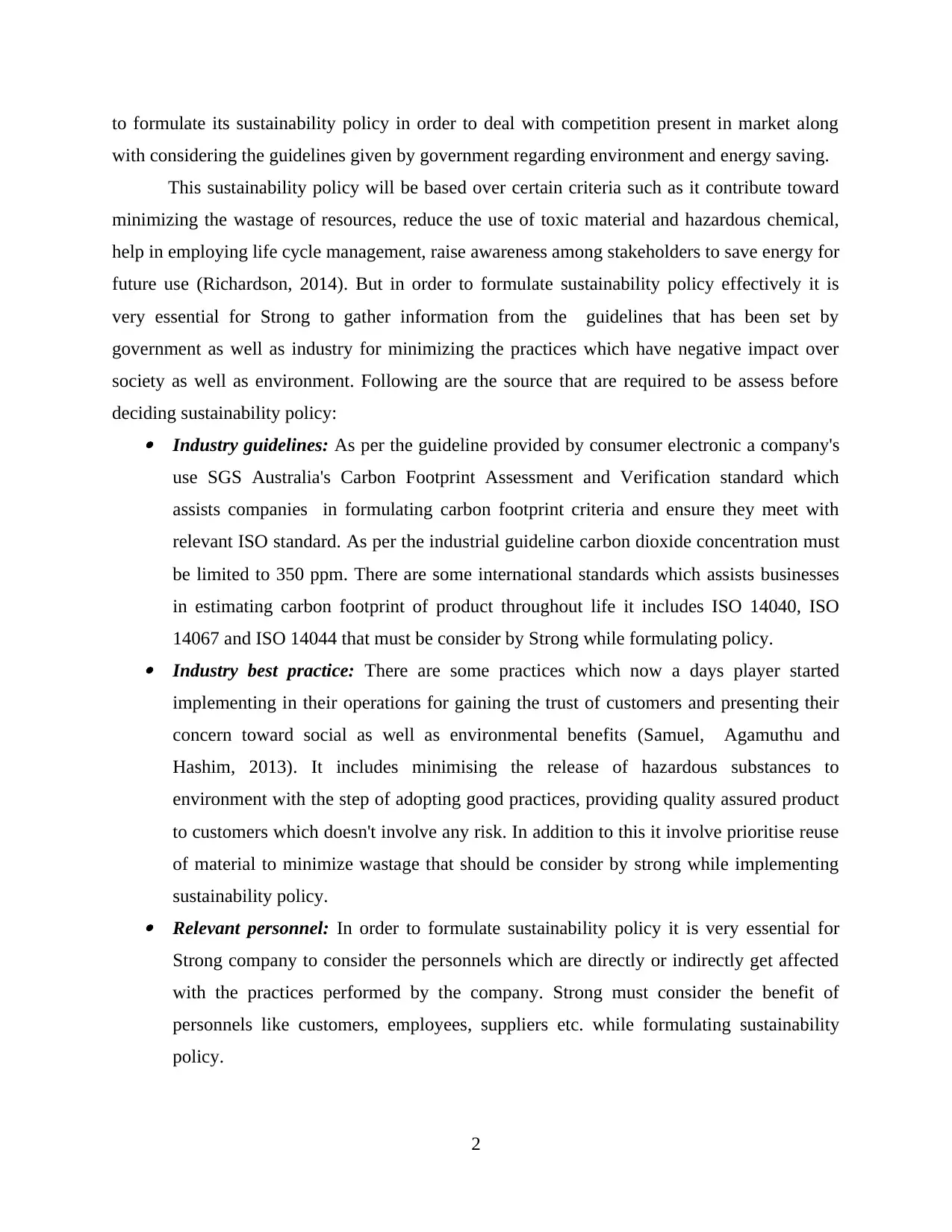
to formulate its sustainability policy in order to deal with competition present in market along
with considering the guidelines given by government regarding environment and energy saving.
This sustainability policy will be based over certain criteria such as it contribute toward
minimizing the wastage of resources, reduce the use of toxic material and hazardous chemical,
help in employing life cycle management, raise awareness among stakeholders to save energy for
future use (Richardson, 2014). But in order to formulate sustainability policy effectively it is
very essential for Strong to gather information from the guidelines that has been set by
government as well as industry for minimizing the practices which have negative impact over
society as well as environment. Following are the source that are required to be assess before
deciding sustainability policy: Industry guidelines: As per the guideline provided by consumer electronic a company's
use SGS Australia's Carbon Footprint Assessment and Verification standard which
assists companies in formulating carbon footprint criteria and ensure they meet with
relevant ISO standard. As per the industrial guideline carbon dioxide concentration must
be limited to 350 ppm. There are some international standards which assists businesses
in estimating carbon footprint of product throughout life it includes ISO 14040, ISO
14067 and ISO 14044 that must be consider by Strong while formulating policy. Industry best practice: There are some practices which now a days player started
implementing in their operations for gaining the trust of customers and presenting their
concern toward social as well as environmental benefits (Samuel, Agamuthu and
Hashim, 2013). It includes minimising the release of hazardous substances to
environment with the step of adopting good practices, providing quality assured product
to customers which doesn't involve any risk. In addition to this it involve prioritise reuse
of material to minimize wastage that should be consider by strong while implementing
sustainability policy. Relevant personnel: In order to formulate sustainability policy it is very essential for
Strong company to consider the personnels which are directly or indirectly get affected
with the practices performed by the company. Strong must consider the benefit of
personnels like customers, employees, suppliers etc. while formulating sustainability
policy.
2
with considering the guidelines given by government regarding environment and energy saving.
This sustainability policy will be based over certain criteria such as it contribute toward
minimizing the wastage of resources, reduce the use of toxic material and hazardous chemical,
help in employing life cycle management, raise awareness among stakeholders to save energy for
future use (Richardson, 2014). But in order to formulate sustainability policy effectively it is
very essential for Strong to gather information from the guidelines that has been set by
government as well as industry for minimizing the practices which have negative impact over
society as well as environment. Following are the source that are required to be assess before
deciding sustainability policy: Industry guidelines: As per the guideline provided by consumer electronic a company's
use SGS Australia's Carbon Footprint Assessment and Verification standard which
assists companies in formulating carbon footprint criteria and ensure they meet with
relevant ISO standard. As per the industrial guideline carbon dioxide concentration must
be limited to 350 ppm. There are some international standards which assists businesses
in estimating carbon footprint of product throughout life it includes ISO 14040, ISO
14067 and ISO 14044 that must be consider by Strong while formulating policy. Industry best practice: There are some practices which now a days player started
implementing in their operations for gaining the trust of customers and presenting their
concern toward social as well as environmental benefits (Samuel, Agamuthu and
Hashim, 2013). It includes minimising the release of hazardous substances to
environment with the step of adopting good practices, providing quality assured product
to customers which doesn't involve any risk. In addition to this it involve prioritise reuse
of material to minimize wastage that should be consider by strong while implementing
sustainability policy. Relevant personnel: In order to formulate sustainability policy it is very essential for
Strong company to consider the personnels which are directly or indirectly get affected
with the practices performed by the company. Strong must consider the benefit of
personnels like customers, employees, suppliers etc. while formulating sustainability
policy.
2
Paraphrase This Document
Need a fresh take? Get an instant paraphrase of this document with our AI Paraphraser
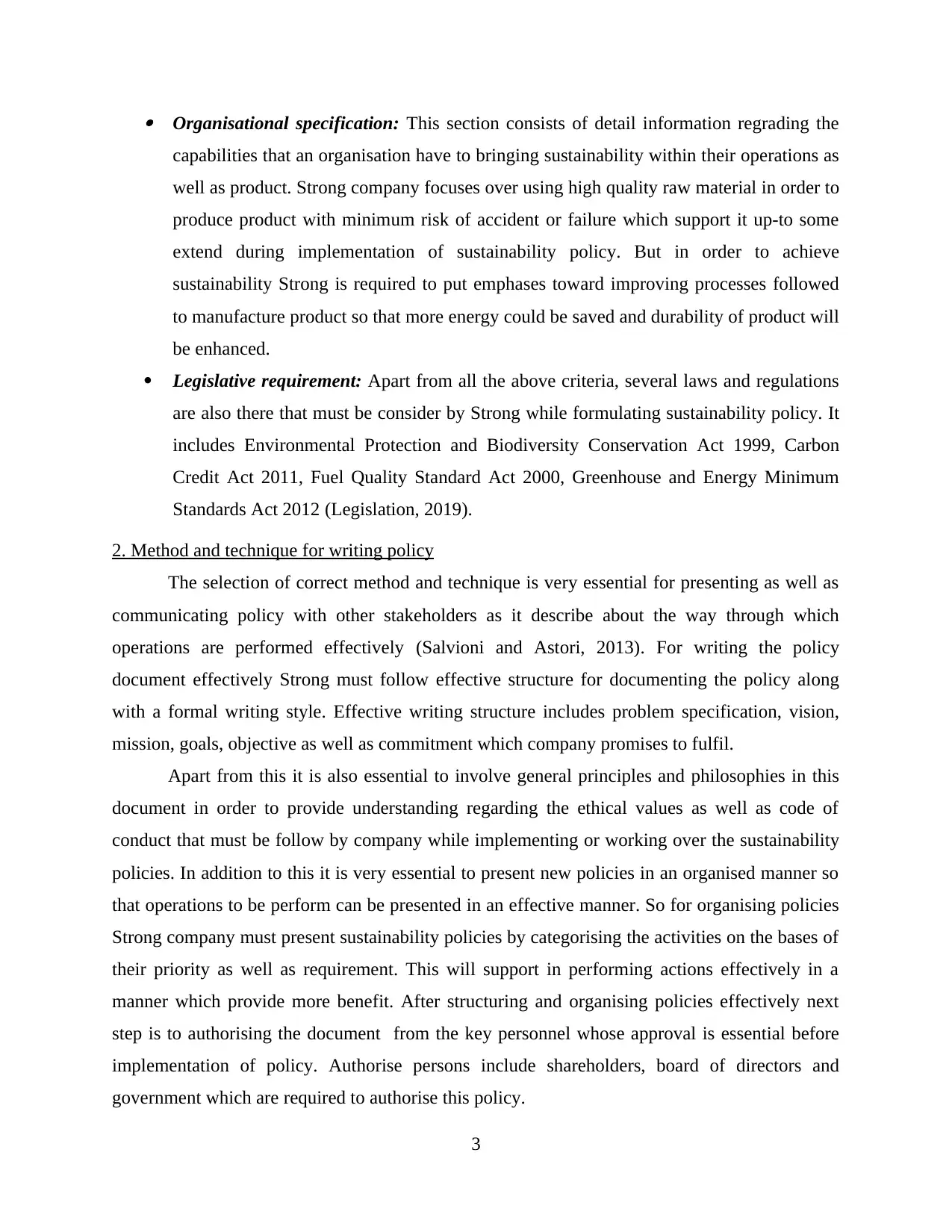
Organisational specification: This section consists of detail information regrading the
capabilities that an organisation have to bringing sustainability within their operations as
well as product. Strong company focuses over using high quality raw material in order to
produce product with minimum risk of accident or failure which support it up-to some
extend during implementation of sustainability policy. But in order to achieve
sustainability Strong is required to put emphases toward improving processes followed
to manufacture product so that more energy could be saved and durability of product will
be enhanced.
Legislative requirement: Apart from all the above criteria, several laws and regulations
are also there that must be consider by Strong while formulating sustainability policy. It
includes Environmental Protection and Biodiversity Conservation Act 1999, Carbon
Credit Act 2011, Fuel Quality Standard Act 2000, Greenhouse and Energy Minimum
Standards Act 2012 (Legislation, 2019).
2. Method and technique for writing policy
The selection of correct method and technique is very essential for presenting as well as
communicating policy with other stakeholders as it describe about the way through which
operations are performed effectively (Salvioni and Astori, 2013). For writing the policy
document effectively Strong must follow effective structure for documenting the policy along
with a formal writing style. Effective writing structure includes problem specification, vision,
mission, goals, objective as well as commitment which company promises to fulfil.
Apart from this it is also essential to involve general principles and philosophies in this
document in order to provide understanding regarding the ethical values as well as code of
conduct that must be follow by company while implementing or working over the sustainability
policies. In addition to this it is very essential to present new policies in an organised manner so
that operations to be perform can be presented in an effective manner. So for organising policies
Strong company must present sustainability policies by categorising the activities on the bases of
their priority as well as requirement. This will support in performing actions effectively in a
manner which provide more benefit. After structuring and organising policies effectively next
step is to authorising the document from the key personnel whose approval is essential before
implementation of policy. Authorise persons include shareholders, board of directors and
government which are required to authorise this policy.
3
capabilities that an organisation have to bringing sustainability within their operations as
well as product. Strong company focuses over using high quality raw material in order to
produce product with minimum risk of accident or failure which support it up-to some
extend during implementation of sustainability policy. But in order to achieve
sustainability Strong is required to put emphases toward improving processes followed
to manufacture product so that more energy could be saved and durability of product will
be enhanced.
Legislative requirement: Apart from all the above criteria, several laws and regulations
are also there that must be consider by Strong while formulating sustainability policy. It
includes Environmental Protection and Biodiversity Conservation Act 1999, Carbon
Credit Act 2011, Fuel Quality Standard Act 2000, Greenhouse and Energy Minimum
Standards Act 2012 (Legislation, 2019).
2. Method and technique for writing policy
The selection of correct method and technique is very essential for presenting as well as
communicating policy with other stakeholders as it describe about the way through which
operations are performed effectively (Salvioni and Astori, 2013). For writing the policy
document effectively Strong must follow effective structure for documenting the policy along
with a formal writing style. Effective writing structure includes problem specification, vision,
mission, goals, objective as well as commitment which company promises to fulfil.
Apart from this it is also essential to involve general principles and philosophies in this
document in order to provide understanding regarding the ethical values as well as code of
conduct that must be follow by company while implementing or working over the sustainability
policies. In addition to this it is very essential to present new policies in an organised manner so
that operations to be perform can be presented in an effective manner. So for organising policies
Strong company must present sustainability policies by categorising the activities on the bases of
their priority as well as requirement. This will support in performing actions effectively in a
manner which provide more benefit. After structuring and organising policies effectively next
step is to authorising the document from the key personnel whose approval is essential before
implementation of policy. Authorise persons include shareholders, board of directors and
government which are required to authorise this policy.
3
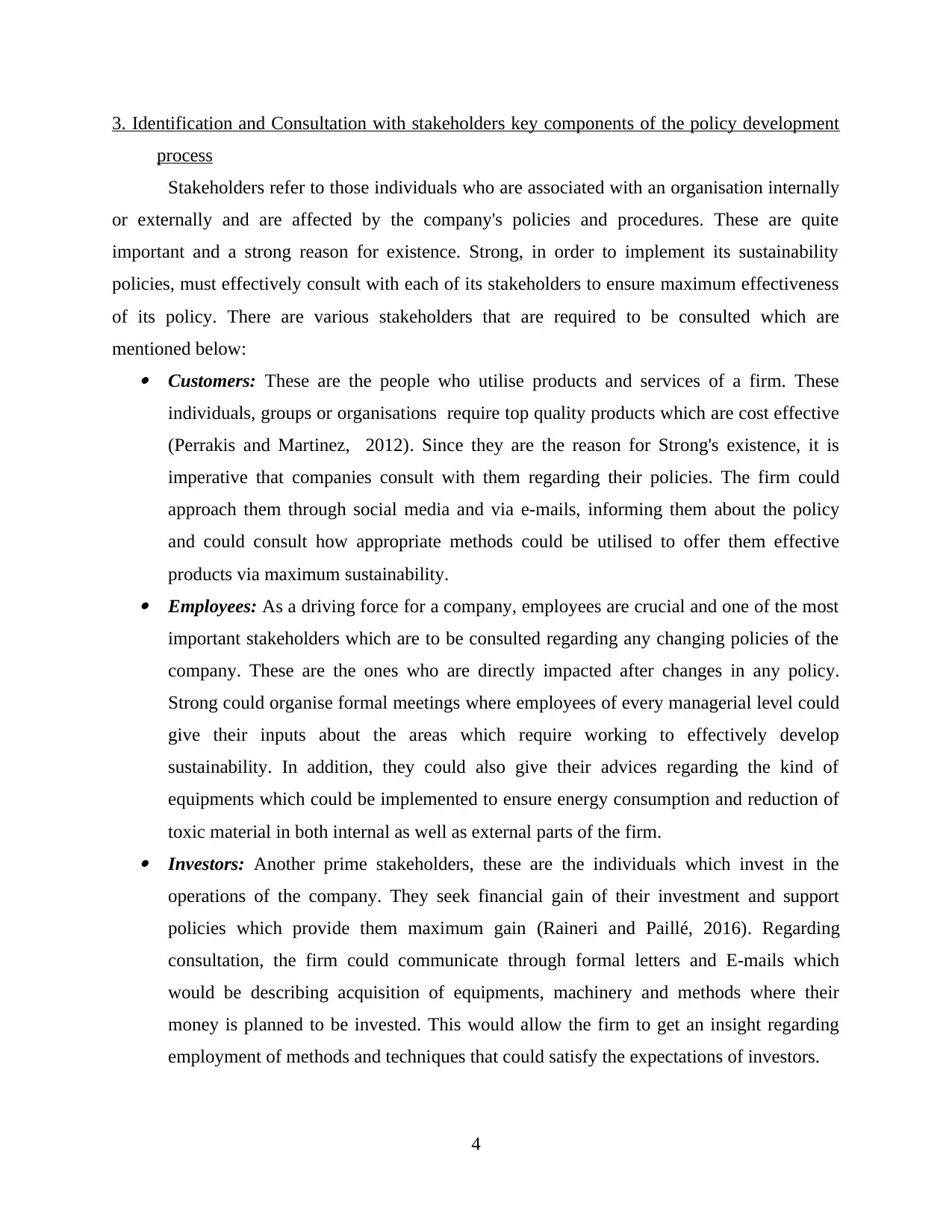
3. Identification and Consultation with stakeholders key components of the policy development
process
Stakeholders refer to those individuals who are associated with an organisation internally
or externally and are affected by the company's policies and procedures. These are quite
important and a strong reason for existence. Strong, in order to implement its sustainability
policies, must effectively consult with each of its stakeholders to ensure maximum effectiveness
of its policy. There are various stakeholders that are required to be consulted which are
mentioned below: Customers: These are the people who utilise products and services of a firm. These
individuals, groups or organisations require top quality products which are cost effective
(Perrakis and Martinez, 2012). Since they are the reason for Strong's existence, it is
imperative that companies consult with them regarding their policies. The firm could
approach them through social media and via e-mails, informing them about the policy
and could consult how appropriate methods could be utilised to offer them effective
products via maximum sustainability. Employees: As a driving force for a company, employees are crucial and one of the most
important stakeholders which are to be consulted regarding any changing policies of the
company. These are the ones who are directly impacted after changes in any policy.
Strong could organise formal meetings where employees of every managerial level could
give their inputs about the areas which require working to effectively develop
sustainability. In addition, they could also give their advices regarding the kind of
equipments which could be implemented to ensure energy consumption and reduction of
toxic material in both internal as well as external parts of the firm. Investors: Another prime stakeholders, these are the individuals which invest in the
operations of the company. They seek financial gain of their investment and support
policies which provide them maximum gain (Raineri and Paillé, 2016). Regarding
consultation, the firm could communicate through formal letters and E-mails which
would be describing acquisition of equipments, machinery and methods where their
money is planned to be invested. This would allow the firm to get an insight regarding
employment of methods and techniques that could satisfy the expectations of investors.
4
process
Stakeholders refer to those individuals who are associated with an organisation internally
or externally and are affected by the company's policies and procedures. These are quite
important and a strong reason for existence. Strong, in order to implement its sustainability
policies, must effectively consult with each of its stakeholders to ensure maximum effectiveness
of its policy. There are various stakeholders that are required to be consulted which are
mentioned below: Customers: These are the people who utilise products and services of a firm. These
individuals, groups or organisations require top quality products which are cost effective
(Perrakis and Martinez, 2012). Since they are the reason for Strong's existence, it is
imperative that companies consult with them regarding their policies. The firm could
approach them through social media and via e-mails, informing them about the policy
and could consult how appropriate methods could be utilised to offer them effective
products via maximum sustainability. Employees: As a driving force for a company, employees are crucial and one of the most
important stakeholders which are to be consulted regarding any changing policies of the
company. These are the ones who are directly impacted after changes in any policy.
Strong could organise formal meetings where employees of every managerial level could
give their inputs about the areas which require working to effectively develop
sustainability. In addition, they could also give their advices regarding the kind of
equipments which could be implemented to ensure energy consumption and reduction of
toxic material in both internal as well as external parts of the firm. Investors: Another prime stakeholders, these are the individuals which invest in the
operations of the company. They seek financial gain of their investment and support
policies which provide them maximum gain (Raineri and Paillé, 2016). Regarding
consultation, the firm could communicate through formal letters and E-mails which
would be describing acquisition of equipments, machinery and methods where their
money is planned to be invested. This would allow the firm to get an insight regarding
employment of methods and techniques that could satisfy the expectations of investors.
4
⊘ This is a preview!⊘
Do you want full access?
Subscribe today to unlock all pages.

Trusted by 1+ million students worldwide
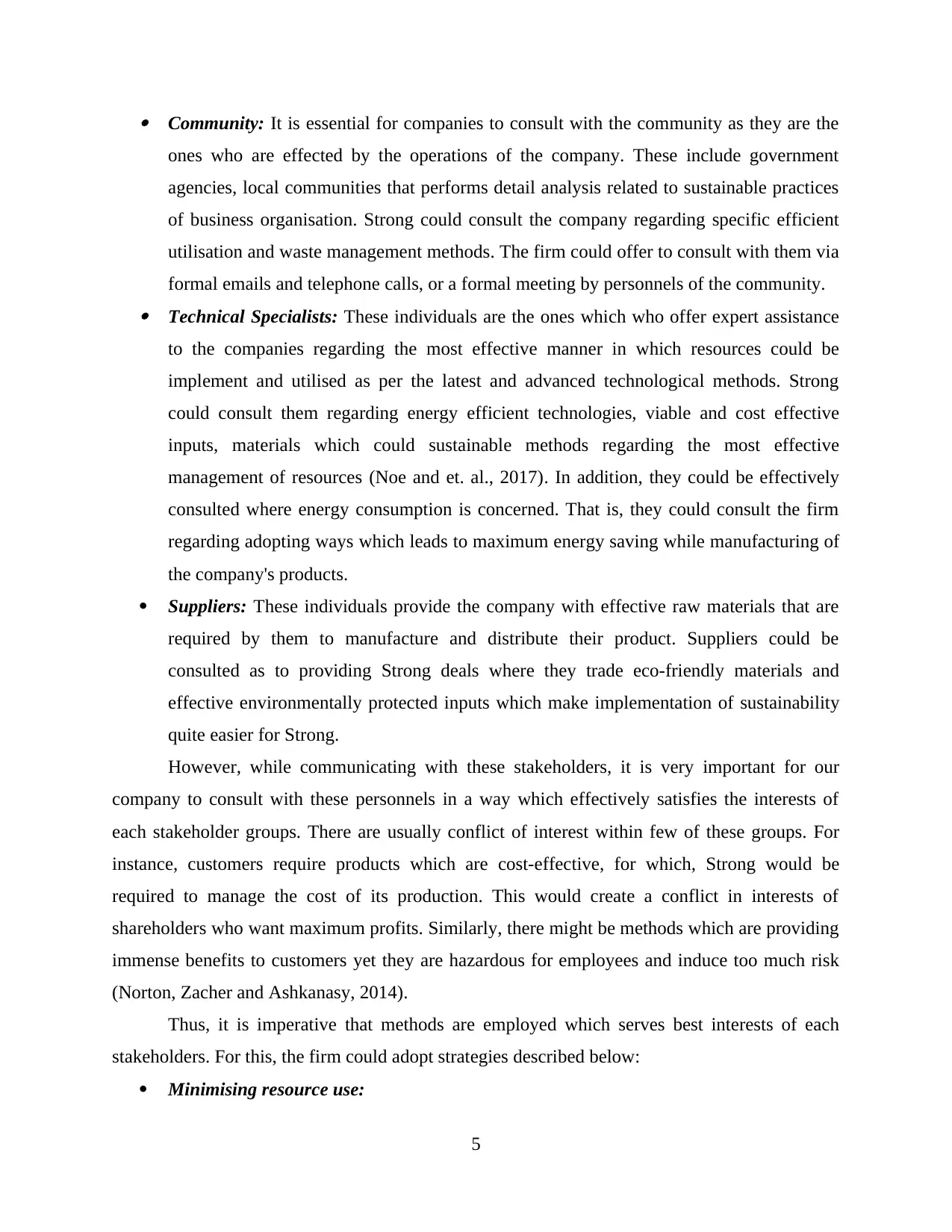
Community: It is essential for companies to consult with the community as they are the
ones who are effected by the operations of the company. These include government
agencies, local communities that performs detail analysis related to sustainable practices
of business organisation. Strong could consult the company regarding specific efficient
utilisation and waste management methods. The firm could offer to consult with them via
formal emails and telephone calls, or a formal meeting by personnels of the community. Technical Specialists: These individuals are the ones which who offer expert assistance
to the companies regarding the most effective manner in which resources could be
implement and utilised as per the latest and advanced technological methods. Strong
could consult them regarding energy efficient technologies, viable and cost effective
inputs, materials which could sustainable methods regarding the most effective
management of resources (Noe and et. al., 2017). In addition, they could be effectively
consulted where energy consumption is concerned. That is, they could consult the firm
regarding adopting ways which leads to maximum energy saving while manufacturing of
the company's products.
Suppliers: These individuals provide the company with effective raw materials that are
required by them to manufacture and distribute their product. Suppliers could be
consulted as to providing Strong deals where they trade eco-friendly materials and
effective environmentally protected inputs which make implementation of sustainability
quite easier for Strong.
However, while communicating with these stakeholders, it is very important for our
company to consult with these personnels in a way which effectively satisfies the interests of
each stakeholder groups. There are usually conflict of interest within few of these groups. For
instance, customers require products which are cost-effective, for which, Strong would be
required to manage the cost of its production. This would create a conflict in interests of
shareholders who want maximum profits. Similarly, there might be methods which are providing
immense benefits to customers yet they are hazardous for employees and induce too much risk
(Norton, Zacher and Ashkanasy, 2014).
Thus, it is imperative that methods are employed which serves best interests of each
stakeholders. For this, the firm could adopt strategies described below:
Minimising resource use:
5
ones who are effected by the operations of the company. These include government
agencies, local communities that performs detail analysis related to sustainable practices
of business organisation. Strong could consult the company regarding specific efficient
utilisation and waste management methods. The firm could offer to consult with them via
formal emails and telephone calls, or a formal meeting by personnels of the community. Technical Specialists: These individuals are the ones which who offer expert assistance
to the companies regarding the most effective manner in which resources could be
implement and utilised as per the latest and advanced technological methods. Strong
could consult them regarding energy efficient technologies, viable and cost effective
inputs, materials which could sustainable methods regarding the most effective
management of resources (Noe and et. al., 2017). In addition, they could be effectively
consulted where energy consumption is concerned. That is, they could consult the firm
regarding adopting ways which leads to maximum energy saving while manufacturing of
the company's products.
Suppliers: These individuals provide the company with effective raw materials that are
required by them to manufacture and distribute their product. Suppliers could be
consulted as to providing Strong deals where they trade eco-friendly materials and
effective environmentally protected inputs which make implementation of sustainability
quite easier for Strong.
However, while communicating with these stakeholders, it is very important for our
company to consult with these personnels in a way which effectively satisfies the interests of
each stakeholder groups. There are usually conflict of interest within few of these groups. For
instance, customers require products which are cost-effective, for which, Strong would be
required to manage the cost of its production. This would create a conflict in interests of
shareholders who want maximum profits. Similarly, there might be methods which are providing
immense benefits to customers yet they are hazardous for employees and induce too much risk
(Norton, Zacher and Ashkanasy, 2014).
Thus, it is imperative that methods are employed which serves best interests of each
stakeholders. For this, the firm could adopt strategies described below:
Minimising resource use:
5
Paraphrase This Document
Need a fresh take? Get an instant paraphrase of this document with our AI Paraphraser
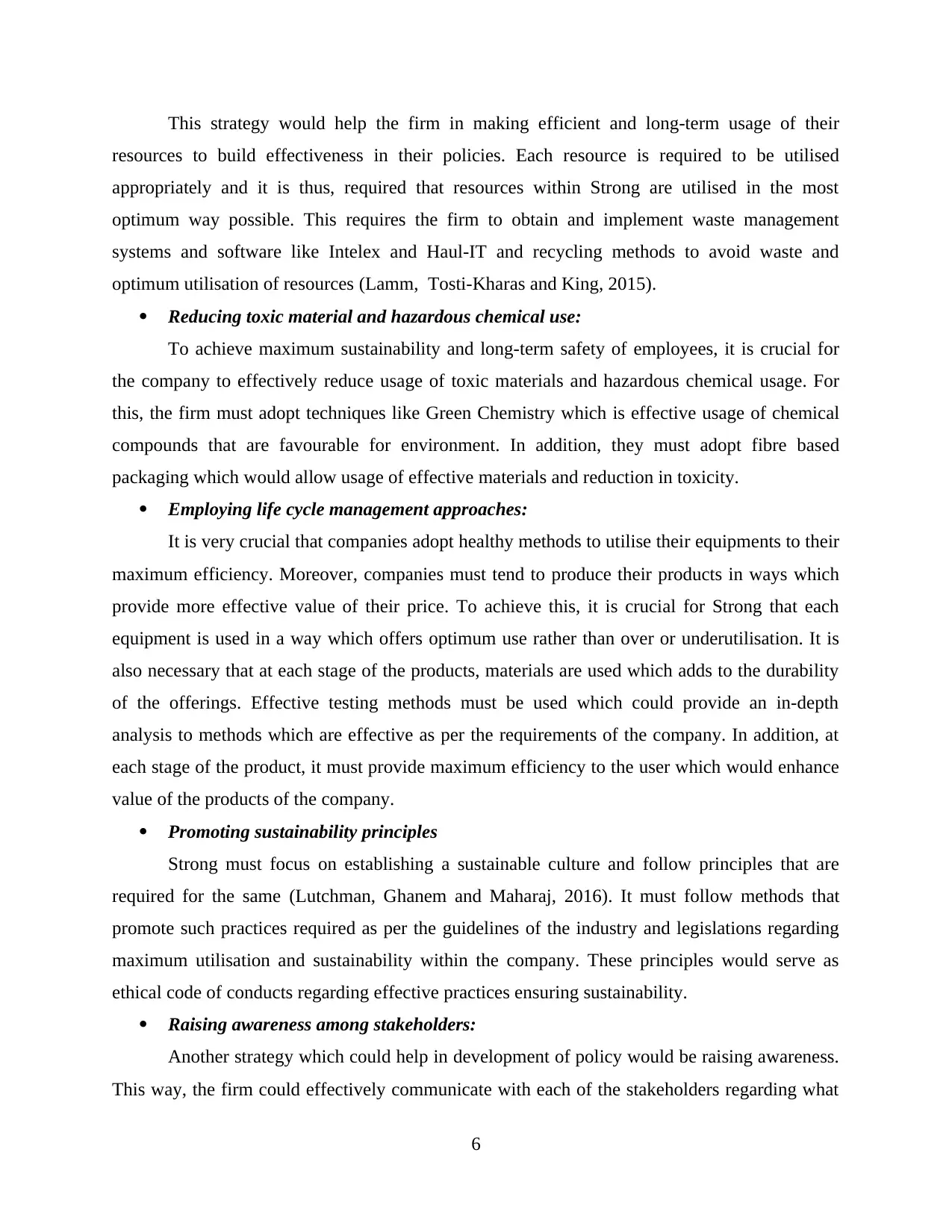
This strategy would help the firm in making efficient and long-term usage of their
resources to build effectiveness in their policies. Each resource is required to be utilised
appropriately and it is thus, required that resources within Strong are utilised in the most
optimum way possible. This requires the firm to obtain and implement waste management
systems and software like Intelex and Haul-IT and recycling methods to avoid waste and
optimum utilisation of resources (Lamm, Tosti-Kharas and King, 2015).
Reducing toxic material and hazardous chemical use:
To achieve maximum sustainability and long-term safety of employees, it is crucial for
the company to effectively reduce usage of toxic materials and hazardous chemical usage. For
this, the firm must adopt techniques like Green Chemistry which is effective usage of chemical
compounds that are favourable for environment. In addition, they must adopt fibre based
packaging which would allow usage of effective materials and reduction in toxicity.
Employing life cycle management approaches:
It is very crucial that companies adopt healthy methods to utilise their equipments to their
maximum efficiency. Moreover, companies must tend to produce their products in ways which
provide more effective value of their price. To achieve this, it is crucial for Strong that each
equipment is used in a way which offers optimum use rather than over or underutilisation. It is
also necessary that at each stage of the products, materials are used which adds to the durability
of the offerings. Effective testing methods must be used which could provide an in-depth
analysis to methods which are effective as per the requirements of the company. In addition, at
each stage of the product, it must provide maximum efficiency to the user which would enhance
value of the products of the company.
Promoting sustainability principles
Strong must focus on establishing a sustainable culture and follow principles that are
required for the same (Lutchman, Ghanem and Maharaj, 2016). It must follow methods that
promote such practices required as per the guidelines of the industry and legislations regarding
maximum utilisation and sustainability within the company. These principles would serve as
ethical code of conducts regarding effective practices ensuring sustainability.
Raising awareness among stakeholders:
Another strategy which could help in development of policy would be raising awareness.
This way, the firm could effectively communicate with each of the stakeholders regarding what
6
resources to build effectiveness in their policies. Each resource is required to be utilised
appropriately and it is thus, required that resources within Strong are utilised in the most
optimum way possible. This requires the firm to obtain and implement waste management
systems and software like Intelex and Haul-IT and recycling methods to avoid waste and
optimum utilisation of resources (Lamm, Tosti-Kharas and King, 2015).
Reducing toxic material and hazardous chemical use:
To achieve maximum sustainability and long-term safety of employees, it is crucial for
the company to effectively reduce usage of toxic materials and hazardous chemical usage. For
this, the firm must adopt techniques like Green Chemistry which is effective usage of chemical
compounds that are favourable for environment. In addition, they must adopt fibre based
packaging which would allow usage of effective materials and reduction in toxicity.
Employing life cycle management approaches:
It is very crucial that companies adopt healthy methods to utilise their equipments to their
maximum efficiency. Moreover, companies must tend to produce their products in ways which
provide more effective value of their price. To achieve this, it is crucial for Strong that each
equipment is used in a way which offers optimum use rather than over or underutilisation. It is
also necessary that at each stage of the products, materials are used which adds to the durability
of the offerings. Effective testing methods must be used which could provide an in-depth
analysis to methods which are effective as per the requirements of the company. In addition, at
each stage of the product, it must provide maximum efficiency to the user which would enhance
value of the products of the company.
Promoting sustainability principles
Strong must focus on establishing a sustainable culture and follow principles that are
required for the same (Lutchman, Ghanem and Maharaj, 2016). It must follow methods that
promote such practices required as per the guidelines of the industry and legislations regarding
maximum utilisation and sustainability within the company. These principles would serve as
ethical code of conducts regarding effective practices ensuring sustainability.
Raising awareness among stakeholders:
Another strategy which could help in development of policy would be raising awareness.
This way, the firm could effectively communicate with each of the stakeholders regarding what
6
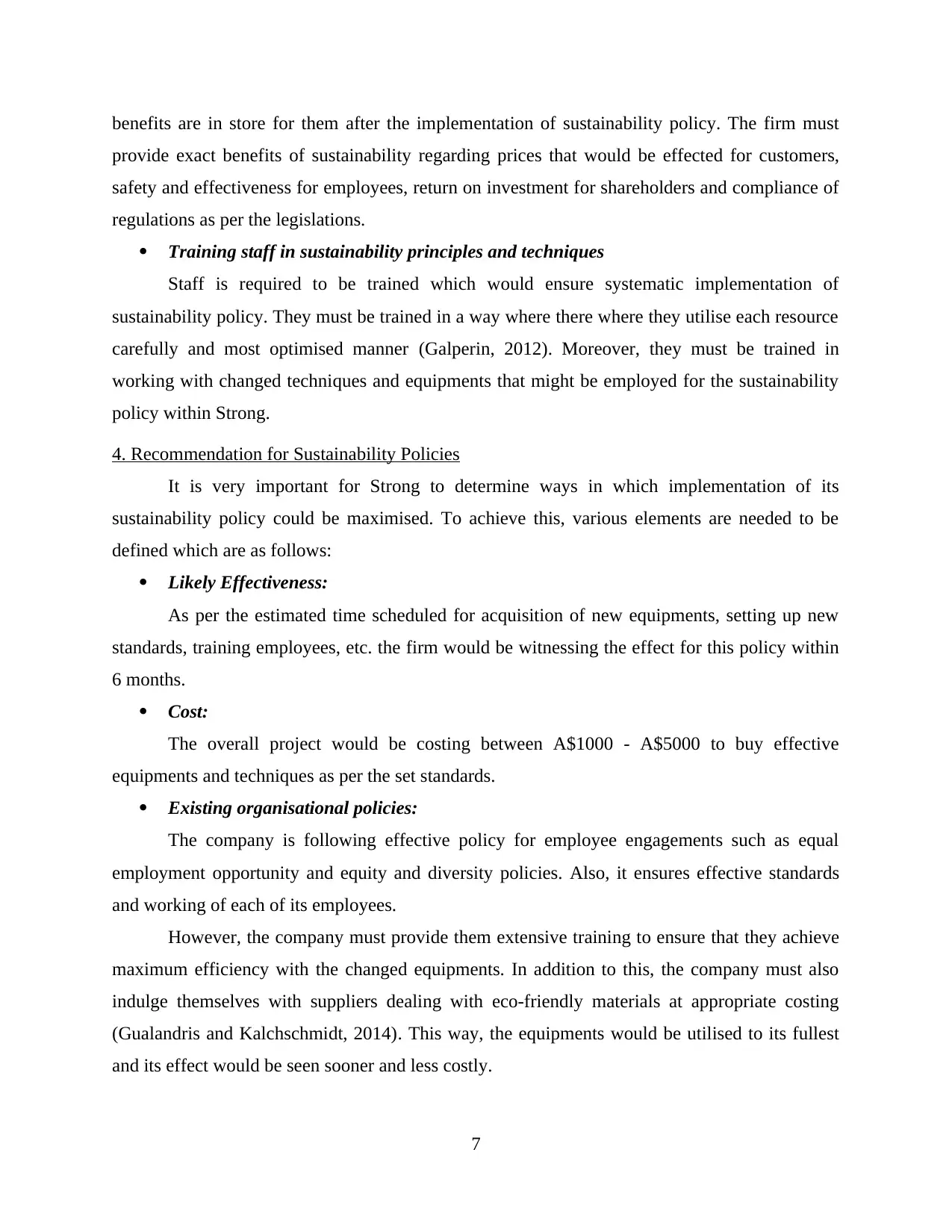
benefits are in store for them after the implementation of sustainability policy. The firm must
provide exact benefits of sustainability regarding prices that would be effected for customers,
safety and effectiveness for employees, return on investment for shareholders and compliance of
regulations as per the legislations.
Training staff in sustainability principles and techniques
Staff is required to be trained which would ensure systematic implementation of
sustainability policy. They must be trained in a way where there where they utilise each resource
carefully and most optimised manner (Galperin, 2012). Moreover, they must be trained in
working with changed techniques and equipments that might be employed for the sustainability
policy within Strong.
4. Recommendation for Sustainability Policies
It is very important for Strong to determine ways in which implementation of its
sustainability policy could be maximised. To achieve this, various elements are needed to be
defined which are as follows:
Likely Effectiveness:
As per the estimated time scheduled for acquisition of new equipments, setting up new
standards, training employees, etc. the firm would be witnessing the effect for this policy within
6 months.
Cost:
The overall project would be costing between A$1000 - A$5000 to buy effective
equipments and techniques as per the set standards.
Existing organisational policies:
The company is following effective policy for employee engagements such as equal
employment opportunity and equity and diversity policies. Also, it ensures effective standards
and working of each of its employees.
However, the company must provide them extensive training to ensure that they achieve
maximum efficiency with the changed equipments. In addition to this, the company must also
indulge themselves with suppliers dealing with eco-friendly materials at appropriate costing
(Gualandris and Kalchschmidt, 2014). This way, the equipments would be utilised to its fullest
and its effect would be seen sooner and less costly.
7
provide exact benefits of sustainability regarding prices that would be effected for customers,
safety and effectiveness for employees, return on investment for shareholders and compliance of
regulations as per the legislations.
Training staff in sustainability principles and techniques
Staff is required to be trained which would ensure systematic implementation of
sustainability policy. They must be trained in a way where there where they utilise each resource
carefully and most optimised manner (Galperin, 2012). Moreover, they must be trained in
working with changed techniques and equipments that might be employed for the sustainability
policy within Strong.
4. Recommendation for Sustainability Policies
It is very important for Strong to determine ways in which implementation of its
sustainability policy could be maximised. To achieve this, various elements are needed to be
defined which are as follows:
Likely Effectiveness:
As per the estimated time scheduled for acquisition of new equipments, setting up new
standards, training employees, etc. the firm would be witnessing the effect for this policy within
6 months.
Cost:
The overall project would be costing between A$1000 - A$5000 to buy effective
equipments and techniques as per the set standards.
Existing organisational policies:
The company is following effective policy for employee engagements such as equal
employment opportunity and equity and diversity policies. Also, it ensures effective standards
and working of each of its employees.
However, the company must provide them extensive training to ensure that they achieve
maximum efficiency with the changed equipments. In addition to this, the company must also
indulge themselves with suppliers dealing with eco-friendly materials at appropriate costing
(Gualandris and Kalchschmidt, 2014). This way, the equipments would be utilised to its fullest
and its effect would be seen sooner and less costly.
7
⊘ This is a preview!⊘
Do you want full access?
Subscribe today to unlock all pages.

Trusted by 1+ million students worldwide
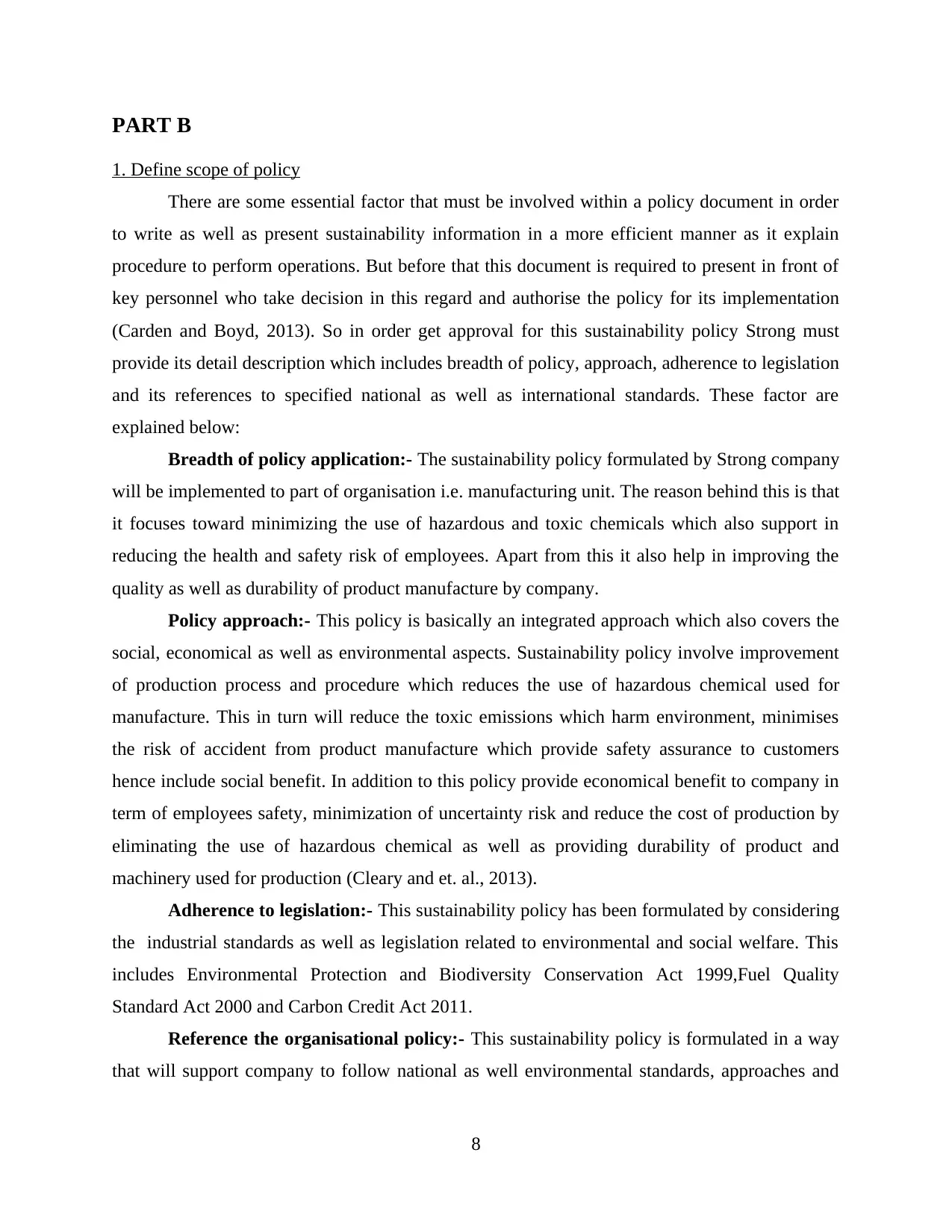
PART B
1. Define scope of policy
There are some essential factor that must be involved within a policy document in order
to write as well as present sustainability information in a more efficient manner as it explain
procedure to perform operations. But before that this document is required to present in front of
key personnel who take decision in this regard and authorise the policy for its implementation
(Carden and Boyd, 2013). So in order get approval for this sustainability policy Strong must
provide its detail description which includes breadth of policy, approach, adherence to legislation
and its references to specified national as well as international standards. These factor are
explained below:
Breadth of policy application:- The sustainability policy formulated by Strong company
will be implemented to part of organisation i.e. manufacturing unit. The reason behind this is that
it focuses toward minimizing the use of hazardous and toxic chemicals which also support in
reducing the health and safety risk of employees. Apart from this it also help in improving the
quality as well as durability of product manufacture by company.
Policy approach:- This policy is basically an integrated approach which also covers the
social, economical as well as environmental aspects. Sustainability policy involve improvement
of production process and procedure which reduces the use of hazardous chemical used for
manufacture. This in turn will reduce the toxic emissions which harm environment, minimises
the risk of accident from product manufacture which provide safety assurance to customers
hence include social benefit. In addition to this policy provide economical benefit to company in
term of employees safety, minimization of uncertainty risk and reduce the cost of production by
eliminating the use of hazardous chemical as well as providing durability of product and
machinery used for production (Cleary and et. al., 2013).
Adherence to legislation:- This sustainability policy has been formulated by considering
the industrial standards as well as legislation related to environmental and social welfare. This
includes Environmental Protection and Biodiversity Conservation Act 1999,Fuel Quality
Standard Act 2000 and Carbon Credit Act 2011.
Reference the organisational policy:- This sustainability policy is formulated in a way
that will support company to follow national as well environmental standards, approaches and
8
1. Define scope of policy
There are some essential factor that must be involved within a policy document in order
to write as well as present sustainability information in a more efficient manner as it explain
procedure to perform operations. But before that this document is required to present in front of
key personnel who take decision in this regard and authorise the policy for its implementation
(Carden and Boyd, 2013). So in order get approval for this sustainability policy Strong must
provide its detail description which includes breadth of policy, approach, adherence to legislation
and its references to specified national as well as international standards. These factor are
explained below:
Breadth of policy application:- The sustainability policy formulated by Strong company
will be implemented to part of organisation i.e. manufacturing unit. The reason behind this is that
it focuses toward minimizing the use of hazardous and toxic chemicals which also support in
reducing the health and safety risk of employees. Apart from this it also help in improving the
quality as well as durability of product manufacture by company.
Policy approach:- This policy is basically an integrated approach which also covers the
social, economical as well as environmental aspects. Sustainability policy involve improvement
of production process and procedure which reduces the use of hazardous chemical used for
manufacture. This in turn will reduce the toxic emissions which harm environment, minimises
the risk of accident from product manufacture which provide safety assurance to customers
hence include social benefit. In addition to this policy provide economical benefit to company in
term of employees safety, minimization of uncertainty risk and reduce the cost of production by
eliminating the use of hazardous chemical as well as providing durability of product and
machinery used for production (Cleary and et. al., 2013).
Adherence to legislation:- This sustainability policy has been formulated by considering
the industrial standards as well as legislation related to environmental and social welfare. This
includes Environmental Protection and Biodiversity Conservation Act 1999,Fuel Quality
Standard Act 2000 and Carbon Credit Act 2011.
Reference the organisational policy:- This sustainability policy is formulated in a way
that will support company to follow national as well environmental standards, approaches and
8
Paraphrase This Document
Need a fresh take? Get an instant paraphrase of this document with our AI Paraphraser
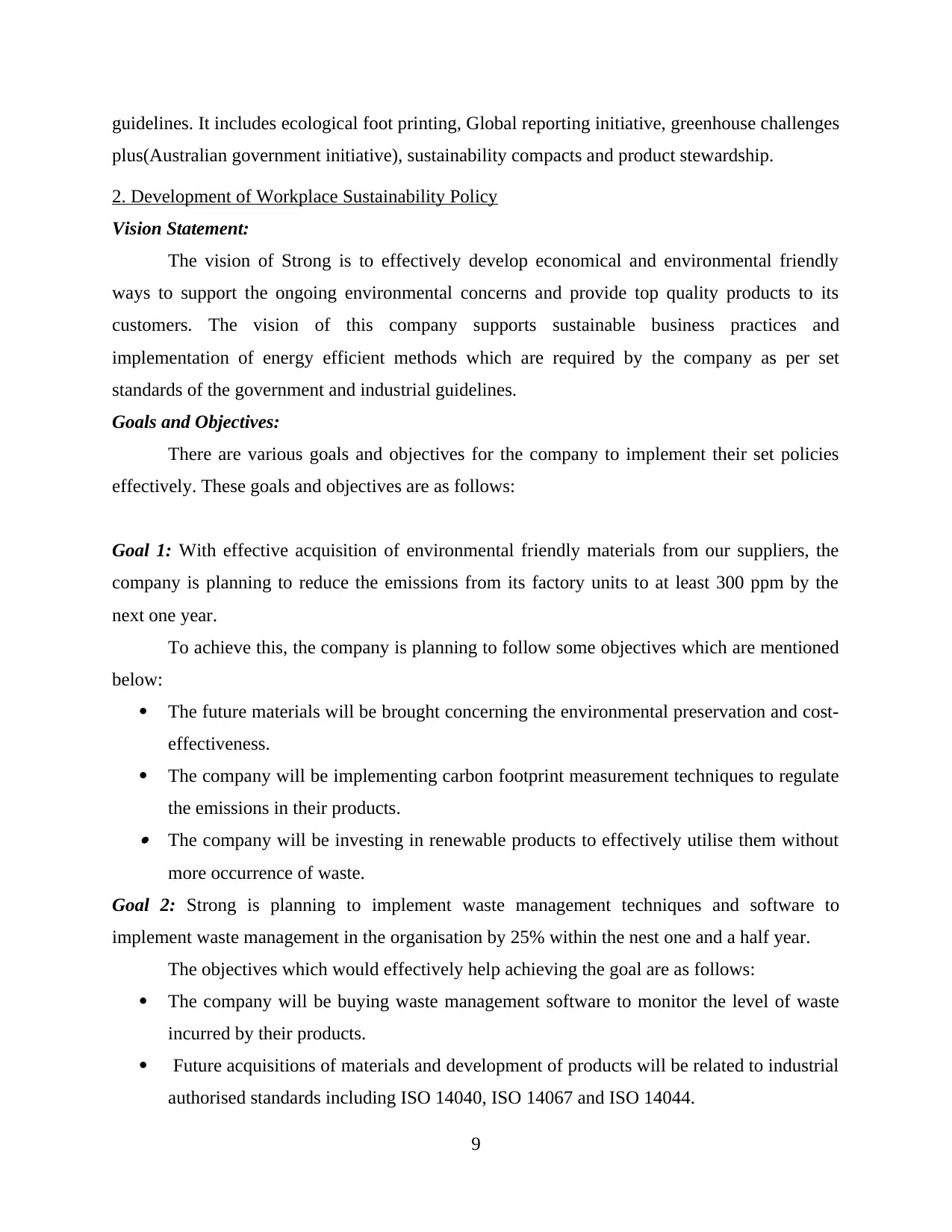
guidelines. It includes ecological foot printing, Global reporting initiative, greenhouse challenges
plus(Australian government initiative), sustainability compacts and product stewardship.
2. Development of Workplace Sustainability Policy
Vision Statement:
The vision of Strong is to effectively develop economical and environmental friendly
ways to support the ongoing environmental concerns and provide top quality products to its
customers. The vision of this company supports sustainable business practices and
implementation of energy efficient methods which are required by the company as per set
standards of the government and industrial guidelines.
Goals and Objectives:
There are various goals and objectives for the company to implement their set policies
effectively. These goals and objectives are as follows:
Goal 1: With effective acquisition of environmental friendly materials from our suppliers, the
company is planning to reduce the emissions from its factory units to at least 300 ppm by the
next one year.
To achieve this, the company is planning to follow some objectives which are mentioned
below:
The future materials will be brought concerning the environmental preservation and cost-
effectiveness.
The company will be implementing carbon footprint measurement techniques to regulate
the emissions in their products. The company will be investing in renewable products to effectively utilise them without
more occurrence of waste.
Goal 2: Strong is planning to implement waste management techniques and software to
implement waste management in the organisation by 25% within the nest one and a half year.
The objectives which would effectively help achieving the goal are as follows:
The company will be buying waste management software to monitor the level of waste
incurred by their products.
Future acquisitions of materials and development of products will be related to industrial
authorised standards including ISO 14040, ISO 14067 and ISO 14044.
9
plus(Australian government initiative), sustainability compacts and product stewardship.
2. Development of Workplace Sustainability Policy
Vision Statement:
The vision of Strong is to effectively develop economical and environmental friendly
ways to support the ongoing environmental concerns and provide top quality products to its
customers. The vision of this company supports sustainable business practices and
implementation of energy efficient methods which are required by the company as per set
standards of the government and industrial guidelines.
Goals and Objectives:
There are various goals and objectives for the company to implement their set policies
effectively. These goals and objectives are as follows:
Goal 1: With effective acquisition of environmental friendly materials from our suppliers, the
company is planning to reduce the emissions from its factory units to at least 300 ppm by the
next one year.
To achieve this, the company is planning to follow some objectives which are mentioned
below:
The future materials will be brought concerning the environmental preservation and cost-
effectiveness.
The company will be implementing carbon footprint measurement techniques to regulate
the emissions in their products. The company will be investing in renewable products to effectively utilise them without
more occurrence of waste.
Goal 2: Strong is planning to implement waste management techniques and software to
implement waste management in the organisation by 25% within the nest one and a half year.
The objectives which would effectively help achieving the goal are as follows:
The company will be buying waste management software to monitor the level of waste
incurred by their products.
Future acquisitions of materials and development of products will be related to industrial
authorised standards including ISO 14040, ISO 14067 and ISO 14044.
9
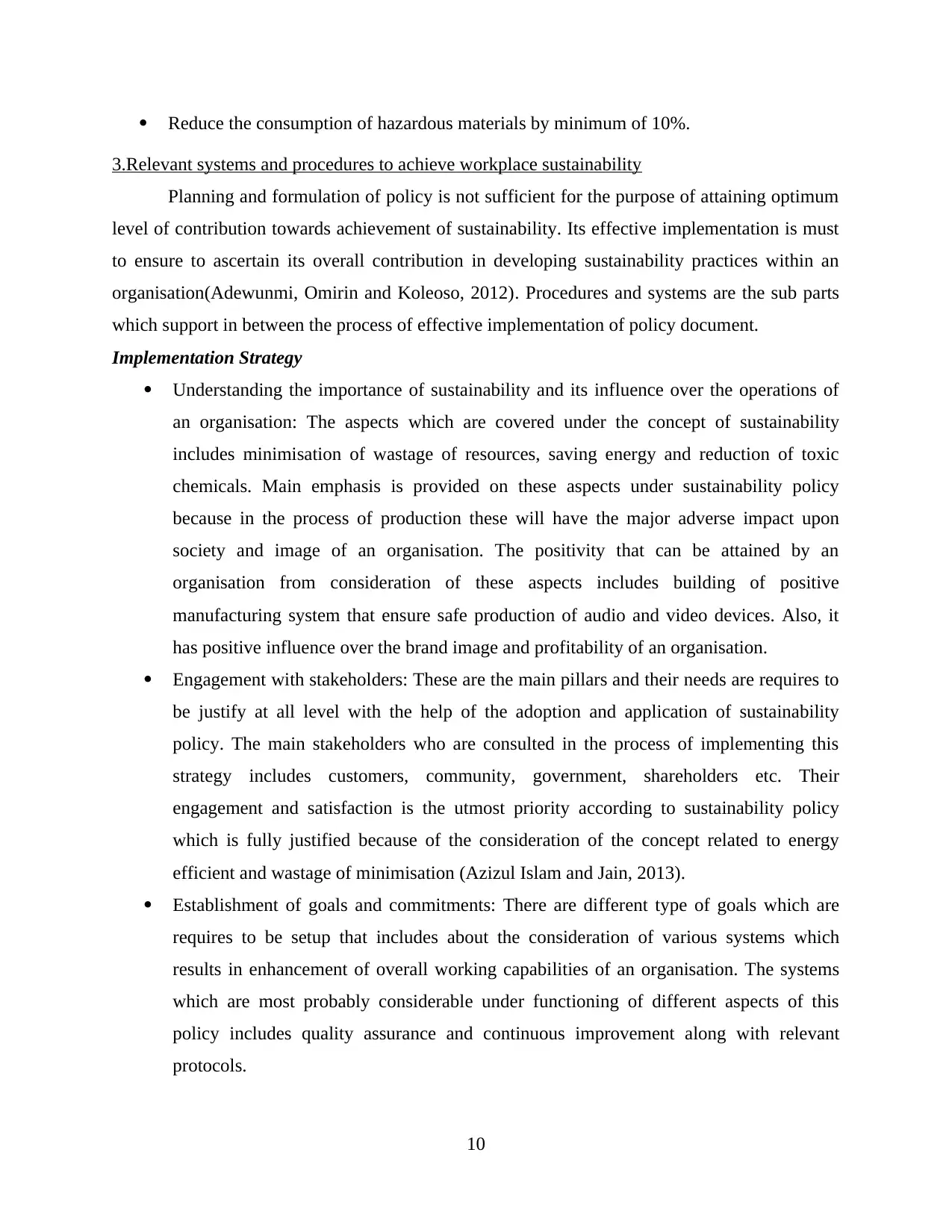
Reduce the consumption of hazardous materials by minimum of 10%.
3.Relevant systems and procedures to achieve workplace sustainability
Planning and formulation of policy is not sufficient for the purpose of attaining optimum
level of contribution towards achievement of sustainability. Its effective implementation is must
to ensure to ascertain its overall contribution in developing sustainability practices within an
organisation(Adewunmi, Omirin and Koleoso, 2012). Procedures and systems are the sub parts
which support in between the process of effective implementation of policy document.
Implementation Strategy
Understanding the importance of sustainability and its influence over the operations of
an organisation: The aspects which are covered under the concept of sustainability
includes minimisation of wastage of resources, saving energy and reduction of toxic
chemicals. Main emphasis is provided on these aspects under sustainability policy
because in the process of production these will have the major adverse impact upon
society and image of an organisation. The positivity that can be attained by an
organisation from consideration of these aspects includes building of positive
manufacturing system that ensure safe production of audio and video devices. Also, it
has positive influence over the brand image and profitability of an organisation.
Engagement with stakeholders: These are the main pillars and their needs are requires to
be justify at all level with the help of the adoption and application of sustainability
policy. The main stakeholders who are consulted in the process of implementing this
strategy includes customers, community, government, shareholders etc. Their
engagement and satisfaction is the utmost priority according to sustainability policy
which is fully justified because of the consideration of the concept related to energy
efficient and wastage of minimisation (Azizul Islam and Jain, 2013).
Establishment of goals and commitments: There are different type of goals which are
requires to be setup that includes about the consideration of various systems which
results in enhancement of overall working capabilities of an organisation. The systems
which are most probably considerable under functioning of different aspects of this
policy includes quality assurance and continuous improvement along with relevant
protocols.
10
3.Relevant systems and procedures to achieve workplace sustainability
Planning and formulation of policy is not sufficient for the purpose of attaining optimum
level of contribution towards achievement of sustainability. Its effective implementation is must
to ensure to ascertain its overall contribution in developing sustainability practices within an
organisation(Adewunmi, Omirin and Koleoso, 2012). Procedures and systems are the sub parts
which support in between the process of effective implementation of policy document.
Implementation Strategy
Understanding the importance of sustainability and its influence over the operations of
an organisation: The aspects which are covered under the concept of sustainability
includes minimisation of wastage of resources, saving energy and reduction of toxic
chemicals. Main emphasis is provided on these aspects under sustainability policy
because in the process of production these will have the major adverse impact upon
society and image of an organisation. The positivity that can be attained by an
organisation from consideration of these aspects includes building of positive
manufacturing system that ensure safe production of audio and video devices. Also, it
has positive influence over the brand image and profitability of an organisation.
Engagement with stakeholders: These are the main pillars and their needs are requires to
be justify at all level with the help of the adoption and application of sustainability
policy. The main stakeholders who are consulted in the process of implementing this
strategy includes customers, community, government, shareholders etc. Their
engagement and satisfaction is the utmost priority according to sustainability policy
which is fully justified because of the consideration of the concept related to energy
efficient and wastage of minimisation (Azizul Islam and Jain, 2013).
Establishment of goals and commitments: There are different type of goals which are
requires to be setup that includes about the consideration of various systems which
results in enhancement of overall working capabilities of an organisation. The systems
which are most probably considerable under functioning of different aspects of this
policy includes quality assurance and continuous improvement along with relevant
protocols.
10
⊘ This is a preview!⊘
Do you want full access?
Subscribe today to unlock all pages.

Trusted by 1+ million students worldwide
1 out of 15
Related Documents
Your All-in-One AI-Powered Toolkit for Academic Success.
+13062052269
info@desklib.com
Available 24*7 on WhatsApp / Email
![[object Object]](/_next/static/media/star-bottom.7253800d.svg)
Unlock your academic potential
Copyright © 2020–2025 A2Z Services. All Rights Reserved. Developed and managed by ZUCOL.





